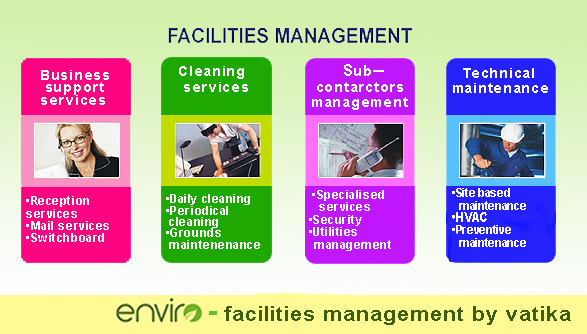Finest Practices for Streamlining Facility Management Processes and Protocols
Finest Practices for Streamlining Facility Management Processes and Protocols
Blog Article
The Crucial Overview to Facility Administration: Strategies for Success
Center administration plays a critical function in the overall success of a company, serving as the backbone that sustains performance, efficiency, and safety and security. The subtleties of effective facility administration expand beyond mere logistics and call for an extensive understanding of both qualitative and measurable metrics.
Understanding Center Administration
What makes up effective center monitoring? Efficient facility administration includes the coordination of various organizational functions to ensure that constructed environments are safe, efficient, and favorable to efficiency. Facility Management. It integrates the concepts of design, engineering, and business management to create a smooth operational flow within an organization
Secret elements of center monitoring include space planning, upkeep monitoring, and conformity with health and wellness guidelines. Area planning concentrates on optimizing the use of physical resources to support organizational goals, while maintenance monitoring ensures that centers are kept in optimum condition, taking full advantage of life expectancy and lowering functional prices. Conformity with legal and regulatory standards is crucial, as it safeguards the company against potential responsibilities and improves its reputation.
In addition, reliable facility management counts on the tactical use innovation, such as Building Management Solution (BMS) and Computer-Aided Facility Monitoring (CAFM) tools. These modern technologies assist in real-time surveillance of structure systems and simplify maintenance procedures. Eventually, a comprehensive technique to facility management not just advertises operational performance however likewise promotes a positive atmosphere for site visitors and employees alike, driving total business success.
Key Methods for Optimization
Maximizing facility monitoring requires a tactical method that aligns operational practices with organizational objectives. To achieve this, the first key strategy is the implementation of incorporated technical remedies. Using innovative software systems allows for real-time tracking of center procedures, helping with data-driven decision-making and enhancing total efficiency.
Secondly, normal evaluations of facility efficiency are crucial. Conducting routine evaluations and audits allows center managers to identify areas that need enhancement, ensuring that sources are designated efficiently. This proactive method aids in reducing downtime and enhancing solution distribution.
An additional critical strategy is cultivating cooperation throughout divisions. By urging open interaction in between teams, center supervisors can much better align their strategies with service goals, bring about improved operational synergy. Furthermore, engaging staff in training programs promotes a society of accountability and improves their ability to contribute to optimization initiatives.
Enhancing Security Protocols
Enhancing safety methods is vital for developing a safe atmosphere within facilities. An extensive safety and security protocol not only safeguards site visitors and staff members yet additionally improves operational performance. To attain this, facility supervisors must carry out routine danger analyses to ensure and recognize prospective dangers that suitable steps are in area.
Training and education and learning are critical parts of efficient security methods - Facility Management. Staff members ought to obtain ongoing training in emergency procedures, devices handling, and personal protective steps. Routine drills, such as fire evacuations or lockdown procedures, foster familiarity and readiness among personnel
In addition, clear interaction networks have to be developed to report security worries promptly. This consists of creating an obtainable platform for workers to voice potential threats or cases without anxiety of . Moreover, leveraging modern technology can improve safety and security steps; for instance, executing security systems and accessibility controls helps keep track of facility activities and restrict unauthorized access.
Finally, conformity with local guidelines and sector requirements is non-negotiable. Normal audits and testimonials of safety methods ensure placement with present regulations and finest techniques. By prioritizing these approaches, facility supervisors can cultivate a society of security that shields all stakeholders and eventually contributes to the company's success.
Improving Work Environment Setting

Ergonomic factors to consider are crucial to minimize physical pressure and pain. Facility Management. This entails giving flexible furniture, appropriate lighting, and adequate space for activity. These changes can lead to decreased absenteeism and raised job fulfillment
Appearances play a vital function in forming the office environment. Using shade psychology, natural lights, and plant can promote a boosting and inviting environment. here Thoughtfully made rooms can increase creativity and improve overall health.
Additionally, encouraging employee involvement with comprehensive decision-making processes can improve the sense of possession and belonging. Gathering responses on work environment renovations and including employees in the layout process can bring about a much more tailored setting that meets their demands.
Last but not least, advertising wellness campaigns, such as wellness programs and relaxation spaces, can better add to a supportive workplace culture. By concentrating on these methods, facility supervisors can successfully improve the office atmosphere, driving both employee contentment and business success.
Gauging Success in Facilities
Determining success in center monitoring needs a detailed strategy that reviews both qualitative and quantitative metrics. Quantitative metrics generally consist of key efficiency indicators (KPIs) such as space utilization rates, power consumption, maintenance prices, and occupancy levels. These metrics supply a clear photo of functional effectiveness and financial efficiency, permitting facility managers to determine locations for improvement and criteria versus industry criteria.
Qualitative metrics, on the other hand, emphasis on user fulfillment and staff member engagement. Surveys and comments systems can determine how well the facilities satisfy the demands of occupants, helping to evaluate the general office atmosphere. This facet is essential, as a completely satisfied workforce is commonly linked to raised productivity and retention prices.
To efficiently determine success, center supervisors should also consider integrating innovation, such as developing administration systems and information analytics devices, to accumulate and evaluate appropriate data. Consistently assessing both collections of metrics allows for a more well balanced sight of efficiency and educates critical choices. Eventually, an effective facility administration technique rests on a commitment to continuous improvement, making sure that both get more info operational efficiencies and user complete satisfaction are prioritized.
Verdict

Facility monitoring plays an important role in the general success of a company, serving as the backbone that supports efficiency, performance, and safety and security.Key aspects of facility administration consist of room planning, upkeep monitoring, and compliance with health and wellness and safety and security policies.In addition, efficient center monitoring relies on the tactical use of innovation, such as Structure Monitoring Equipment (BMS) and Computer-Aided Center Management (CAFM) tools. Ultimately, an extensive technique to center administration not only promotes operational effectiveness but likewise promotes a positive environment for visitors and more info employees alike, driving overall organizational success.
Ultimately, a successful facility monitoring approach pivots on a dedication to continuous improvement, guaranteeing that both operational effectiveness and individual fulfillment are prioritized.
Report this page